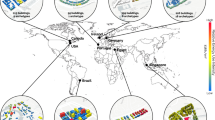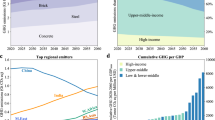Abstract
The anticipated growth and urbanization of the global population over the next several decades will create a vast demand for the construction of new housing, commercial buildings and accompanying infrastructure. The production of cement, steel and other building materials associated with this wave of construction will become a major source of greenhouse gas emissions. Might it be possible to transform this potential threat to the global climate system into a powerful means to mitigate climate change? To answer this provocative question, we explore the potential of mid-rise urban buildings designed with engineered timber to provide long-term storage of carbon and to avoid the carbon-intensive production of mineral-based construction materials.
This is a preview of subscription content, access via your institution
Access options
Access Nature and 54 other Nature Portfolio journals
Get Nature+, our best-value online-access subscription
$29.99 / 30 days
cancel any time
Subscribe to this journal
Receive 12 digital issues and online access to articles
$119.00 per year
only $9.92 per issue
Buy this article
- Purchase on Springer Link
- Instant access to full article PDF
Prices may be subject to local taxes which are calculated during checkout




Similar content being viewed by others
Data availability
All data analysed in this study are included in its supplementary information files.
Code availability
The mathematical algorithm used in this study is available from the corresponding author upon reasonable request.
References
Ward, P. & Kirschvink, J. A New History of Life: The New Discoveries About the Origins and Evolution of the Life on Earth (Bloomsbury Press, 2015).
Nelsen, M. P., DiMichele, W. A., Peters, S. E. & Boyce, C. K. Delayed fungal evolution did not cause the Paleozoic peak in coal production. Proc. Natl Acad. Sci. USA 113, 2442–2447 (2016).
Zhu, Z. et al. Greening of the Earth and its drivers. Nat. Clim. Change 6, 791–795 (2016).
Schimel, D., Stephens, B. B. & Fisher, J. B. Effect of increasing CO2 on the terrestrial carbon cycle. Proc. Natl Acad. Sci. USA 112, 436–441 (2015).
Hyvönen, R. et al. The likely impact of elevated [CO2], nitrogen deposition, increased temperature and management on carbon sequestration in temperate and boreal forest ecosystems: a literature review. New Phytol. 173, 463–480 (2007).
Pan, Y. et al. A large and persistent carbon sink in the world’s forests. Science 333, 988–993 (2011).
Reyer, C. Forest productivity under environmental change—a review of stand-scale modeling studies. Curr. For. Rep. 1, 53–68 (2015).
Friend, A. D. et al. Carbon residence time dominates uncertainty in terrestrial vegetation responses to future climate and atmospheric CO2. Proc. Natl Acad. Sci. USA 111, 3280–3285 (2014).
Norby, R. J., Warren, J. M., Iversen, C. M., Medlyn, B. E. & McMurtrie, R. E. CO2 enhancement of forest productivity constrained by limited nitrogen availability. Proc. Natl Acad. Sci. USA 107, 19368–19373 (2010).
Luyssaert, S. et al. Trade-offs in using European forests to meet climate objectives. Nature 562, 259–262 (2018).
Reyer, C. P. O. et al. Are forest disturbances amplifying or canceling out climate change-induced productivity changes in European forests? Environ. Res. Lett. 12, 034027 (2017).
Seidl, R. et al. Forest disturbances under climate change. Nat. Clim. Change 7, 395–402 (2017).
Seidl, R., Schelhaas, M.-J., Rammer, W. & Verkerk, P. J. Increasing forest disturbances in Europe and their impact on carbon storage. Nat. Clim. Change 4, 806–810 (2014).
Ciais, P. et al. Europe-wide reduction in primary productivity caused by the heat and drought in 2003. Nature 437, 529–533 (2005).
Brienen, R. J. W. et al. Long-term decline of the Amazon carbon sink. Nature 519, 344–348 (2015).
Paris Agreement (UNFCCC, 2015).
Some Progress since Paris, but Not Enough, as Governments Amble towards 3°C of Warming (Climate Action Tracker, 2018).
IPCC Climate Change 2014: Mitigation of Climate Change (eds Edenhofer, O. et al.) (Cambridge Univ. Press, 2014).
Burns, W. & Nicholson, S. Bioenergy and carbon capture with storage (BECCS): the prospects and challenges of an emerging climate policy response. J. Environ. Stud. Sci. 7, 527–534 (2017).
Schulze, E.-D., Körner, C., Law, B. E., Haberl, H. & Luyssaert, S. Large-scale bioenergy from additional harvest of forest biomass is neither sustainable nor greenhouse gas neutral. GCB Bioenergy 4, 611–616 (2012).
Boysen, L. R. et al. The limits to global-warming mitigation by terrestrial carbon removal. Earth’s Future 5, 463–474 (2017).
United Nations Department of Economic and Social Affairs Population Division World Urbanization Prospects: The 2018 Revision (United Nations, 2018).
Rockström, J. et al. A roadmap for rapid decarbonization. Science 355, 1269–1271 (2017).
Müller, D. B. et al. Carbon emissions of infrastructure development. Environ. Sci. Technol. 47, 11739–11746 (2013).
Gutowski, T. G., Sahni, S., Allwood, J. M., Ashby, M. F. & Worrell, E. The energy required to produce materials: constraints on energy-intensity improvements, parameters of demand. Philos. Trans. R. Soc. A 371, 20120003 (2013).
Davis, S. J. et al. Net-zero emissions energy systems. Science 360, eaas9793 (2018).
Andrew, R. M. Global CO2 emissions from cement production, 1928–2017. Earth Syst. Sci. Data 10, 2213–2239 (2018).
Xi, F. et al. Substantial global carbon uptake by cement carbonation. Nat. Geosci. 9, 880–883 (2016).
Cullen, J. M., Allwood, J. M. & Bambach, M. D. Mapping the global flow of steel: from steelmaking to end-use goods. Environ. Sci. Technol. 46, 13048–13055 (2012).
UNEP Environmental Risks and Challenges of Anthropogenic Metals Flows and Cycles (UNEP DTIE, Sustainable Consumption and Production Branch, 2013).
UNEP Recycling Rates of Metals - A Status Report (UNEP DTIE, Sustainable Consumption and Production Branch, 2011).
Pauliuk, S., Milford, R. L., Müller, D. B. & Allwood, J. M. The Steel Scrap Age. Environ. Sci. Technol. 47, 3448–3454 (2013).
Reck, B. K. & Graedel, T. E. Challenges in metal recycling. Science 337, 690–695 (2012).
Torres, A., Brandt, J., Lear, K. & Liu, J. A looming tragedy of the sand commons. Science 357, 970–971 (2017).
Sonter, L. J. et al. Mining drives extensive deforestation in the Brazilian Amazon. Nat. Commun. 8, 1013 (2017).
Stapel, P. & van de Kuilen, J.-W. G. Effects of grading procedures on the scatter of characteristic values of European grown sawn timber. Mater. Struct. 46, 1587–1598 (2013).
Ridley-Ellis, D., Stapel, P. & Baño, V. Strength grading of sawn timber in Europe: an explanation for engineers and researchers. Eur. J. Wood Wood Prod. 74, 291–306 (2016).
Ramage, M. H. et al. The wood from the trees: the use of timber in construction. Renew. Sustain. Energy Rev. 68, 333–359 (2017).
Kobes, M., Helsloot, I., de Vries, B. & Post, J. G. Building safety and human behaviour in fire: a literature review. Fire Saf. J. 45, 1–11 (2010).
Buchanan, A. H. & Abu, A. K. Structural Design for Fire Safety 2nd edn (Wiley, 2017).
Ramage, M. H. Supertall timber: functional natural materials for high-rise structures. Bridge 48, 33–36 (2018).
Organschi, A., Ruff, A., Oliver, C. D., Carbone, C. & Herrmann, E. Timber city: Growing an urban carbon sink with glue, screws, and cellulose fiber. In World Conference on Timber Engineering (WCTE) 2016 (eds Eberhardsteiner, J. et al.) 5612–5621 (TU Verlag, 2016).
Moncaster, A. M., Pomponi, F., Symons, K. E. & Guthrie, P. M. Why method matters: temporal, spatial and physical variations in LCA and their impact on choice of structural system. Energy Build. 173, 389–398 (2018).
Smyth, C. E. et al. Quantifying the biophysical climate change mitigation potential of Canada’s forest sector. Biogeosciences 11, 3515–3529 (2014).
Werner, F., Taverna, R., Hofer, P. & Richter, K. Greenhouse gas dynamics of an increased use of wood in buildings in Switzerland. Clim. Change 74, 319–347 (2006).
Lundmark, T. et al. Potential roles of Swedish forestry in the context of climate change mitigation. Forests 5, 557–578 (2014).
Eriksson, L. O. et al. Climate change mitigation through increased wood use in the European construction sector—towards an integrated modelling framework. Eur. J. For. Res. 131, 131–144 (2012).
Oliver, C. D., Nassar, N. T., Lippke, B. R. & McCarter, J. B. Carbon, fossil fuel, and biodiversity mitigation with wood and forests. J. Sustain. For. 33, 248–275 (2014).
Churkina, G. Can use of Wood in Future Infrastructure Development Reduce Emissions of CO 2? (WBGU, 2016).
Lin, C., Liu, G. & Müller, D. B. Characterizing the role of built environment stocks in human development and emission growth. Resour. Conserv. Recycl. 123, 67–72 (2017).
Administrative Report Report No. 12978 (City of Vancouver, 2019).
BP Statistical Review of World Energy (BP Global, 2016).
Lauk, C., Haberl, H., Erb, K.-H., Gingrich, S. & Krausmann, F. Global socioeconomic carbon stocks in long-lived products 1900–2008. Environ. Res. Lett. 7, 034023 (2012).
Köhl, M. et al. Changes in forest production, biomass and carbon: results from the 2015 UN FAO Global Forest Resource Assessment. For. Ecol. Manag. 352, 21–34 (2015).
Churkina, G. The role of urbanization in the global carbon cycle. Front. Ecol. Evol. 3, 144 (2016).
Made of Air (Made of Air GmbH, 2019); http://www.madeofair.com/
Churkina, G., Brown, D. & Keoleian, G. A. Carbon stored in human settlements: the conterminous US. Glob. Change Biol. 16, 135–143 (2010).
Law, B. E. & Waring, R. H. Carbon implications of current and future effects of drought, fire and management on Pacific Northwest forests. For. Ecol. Manag. 355, 4–14 (2015).
Hossain, M. U. & Poon, C. S. Comparative LCA of wood waste management strategies generated from building construction activities. J. Clean. Prod. 177, 387–397 (2018).
Güneralp, B. et al. Global scenarios of urban density and its impacts on building energy use through 2050. Proc. Natl Acad. Sci. USA 114, 8945–8950 (2017).
Heeren, N. & Fishman, T. A database seed for a community-driven material intensity research platform. Sci. Data 6, 23 (2019).
Law, B. E. et al. Land use strategies to mitigate climate change in carbon dense temperate forests. Proc. Natl Acad. Sci. USA 115, 3663–3668 (2018).
100% Wood (Thoma, 2019); https://www.thoma.at/100-percent-wood/?lang=en
Mudd, G. M. The environmental sustainability of mining in Australia: key mega-trends and looming constraints. Resour. Policy 35, 98–115 (2010).
Cole, R. J. & Kernan, P. C. Life-cycle energy use in office buildings. Build. Environ. 31, 307–317 (1996).
Dixit, M. K. Life cycle recurrent embodied energy calculation of buildings: a review. J. Clean. Prod. 209, 731–754 (2019).
Pomponi, F. & Moncaster, A. Scrutinising embodied carbon in buildings: the next performance gap made manifest. Renew. Sustain. Energy Rev. 81, 2431–2442 (2018).
Ozarska, B. A review of the utilisation of hardwoods for LVL. Wood Sci. Technol. 33, 341–351 (1999).
Sharma, B., Gatóo, A., Bock, M. & Ramage, M. Engineered bamboo for structural applications. Constr. Build. Mater. 81, 66–73 (2015).
FAOSTAT-Forestry Database (FAO, 2016).
Pilli, R., Grassi, G., Kurz, W. A., Fiorese, G. & Cescatti, A. The European forest sector: past and future carbon budget and fluxes under different management scenarios. Biogeosciences 14, 2387–2405 (2017).
Global Forest Resources Assessment 2015 (FAO, 2015).
Carle, J. & Holmgren, P. Wood from planted forests. A global outlook 2005–2030. For. Prod. J. 58, 6–18 (2008).
Yousefpour, R., Nabel, J. E. M. S. & Pongratz, J. Simulating growth-based harvest adaptive to future climate change. Biogeosciences 16, 241–254 (2019).
Yuen, J. Q., Fung, T. & Ziegler, A. D. Carbon stocks in bamboo ecosystems worldwide: estimates and uncertainties. For. Ecol. Manag. 393, 113–138 (2017).
Nabuurs, G.-J. et al. First signs of carbon sink saturation in European forest biomass. Nat. Clim. Change 3, 792–796 (2013).
Clark, C. W. Mathematical Bioeconomics: The Optimal Management of Renewable Resources (John Wiley, 1990).
He, M. et al. Risk assessment of CO2 injection processes and storage in carboniferous formations: a review. J. Rock Mech. Geotech. Eng. 3, 39–56 (2011).
Zeng, N. Carbon sequestration via wood burial. Carbon Balance Manag. 3, 1 (2008).
General Guidelines for the Sustainable Management of Forests in Europe (Resolution H11 of MCPFE, 1993).
Fritz, A. & Graves, A. Farmer Managed Natural Regeneration in the Sahel: A Literature Review (The Mitchell Group, 2016).
Going Green: A Handbook of Sustainable Housing Practices in Developing Countries (UN-HABITAT, 2012).
State of the World’s Forest 2011 (FAO, 2014).
Acknowledgements
We thank K. Seto, C. Oliver, R. Miller, D. Sprinz, R. Lundberg and E. Lundberg for reading and commenting on the manuscript. We are grateful for discussions and suggestions to our approach to S. Running, V. Brovkin, L. Boysen, J. Pongratz, T. Rinaudo and A. Tofu. We thank M. Wodinski for help with graphic design. The research of G.C. was supported by the German Science Foundation (Deutsche Forschungsgemeinschaft, CH 413/7). A.O. and A.R. are grateful for support from the Hines Fund for Advanced Sustainability Research in Architecture at Yale University School of Architecture. C.P.O.R. acknowledges funding from the German Federal Ministry of Education and Research (BMBF, grant no. 01LS1201A1). K.V. acknowledges funding from The International Climate Initiative (IKI: www.international-climate-initiative.com) and the Federal Ministry for the Environment, Nature Conservation and Nuclear Safety (BMU) which supports the IKI on the basis of a decision adopted by the German Bundestag. Z.L. acknowledges funding from Qiushi Foundation, the Resnick Sustainability Institute at California Institute of Technology and the National Natural Science Foundation of China (71874097, 41921005).
Author information
Authors and Affiliations
Contributions
G.C., A.O. and H.J.S. designed the study. A.O. and A.R. provided building typologies and associated data. C.P.O.R. and G.C. assessed the timber amounts available from the world’s forests. G.C. developed methods for estimating carbon emissions and storage at the global scale. B.K.R. and T.E.G. provided expertise for steel materials and embodied energy calculations. Z.L. provided expertise for cement and concrete and respective data. K.V. supplied expertise on political, social and cultural implications of the transition. All authors contributed to discussing the results and writing the manuscript.
Corresponding author
Ethics declarations
Competing interests
The authors declare no competing interests.
Additional information
Publisher’s note Springer Nature remains neutral with regard to jurisdictional claims in published maps and institutional affiliations.
Extended data
Extended Data Fig. 1
Primary structures designed for typical, mid-rise residential and commercial building morphologies.
Extended Data Fig. 2 Difference between absolute net annual increment (NAI) and wood removals for the non-protected forest area of sixty-five FAO countries/regions for 1990–2010.
The bars indicate how much newly grown wood (NAI) is available after subtracting wood removals for sixty-five countries/regions grouped by the sign of this difference. Black bars indicate that the increment is larger than the wood removals. Grey bars indicate that the removals are larger than the increment. Error bars indicate the range induced by using a minimum and maximum wood density of 400 and 900 kg m–3 respectively when calculating the carbon content.
Supplementary information
Supplementary Information
Supplementary Methods, Tables 1–10 and references.
Rights and permissions
About this article
Cite this article
Churkina, G., Organschi, A., Reyer, C.P.O. et al. Buildings as a global carbon sink. Nat Sustain 3, 269–276 (2020). https://doi.org/10.1038/s41893-019-0462-4
Received:
Accepted:
Published:
Issue Date:
DOI: https://doi.org/10.1038/s41893-019-0462-4
This article is cited by
-
Quantifying the impact of key factors on the carbon mitigation potential of managed temperate forests
Carbon Balance and Management (2024)
-
Strategies for robust renovation of residential buildings in Switzerland
Nature Communications (2024)
-
Explainable XGBoost machine learning model for prediction of ultimate load and free end slip of GFRP rod glued-in timber joints through a pull-out test under various harsh environmental conditions
Asian Journal of Civil Engineering (2024)
-
Effect of targeted acetylation on wood–water interactions at high moisture states
Cellulose (2024)
-
Uncovering the world’s largest carbon sink—a profile of ocean carbon sinks research
Environmental Science and Pollution Research (2024)



